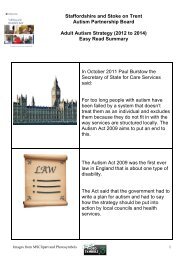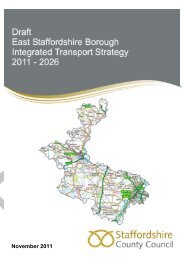nationalCommunitySafetyPlan200811 - Staffordshire County Council
nationalCommunitySafetyPlan200811 - Staffordshire County Council
nationalCommunitySafetyPlan200811 - Staffordshire County Council
Create successful ePaper yourself
Turn your PDF publications into a flip-book with our unique Google optimized e-Paper software.
36 NATIONAL COMMUNITY SAFETY PLAN 2008–11<br />
■ Identify the members of violent gangs in the local<br />
area and intervene to prevent gang-related violence,<br />
particularly involving the use of fi rearms, including<br />
through mediation, use of the civil justice system<br />
and other disruptive tactics, and working closely<br />
with other agencies, partners and the community.<br />
■ Make appropriate use of DIP and the PPO<br />
Programme to tackle drug-related acquisitive crime<br />
and persistent offending.<br />
– Ensure that prolifi c and other priority offenders<br />
are actively targeted, monitored and managed<br />
under the ‘Catch and Convict’ strand of the<br />
PPO strategy.<br />
– Work with other criminal justice agencies,<br />
particularly NOMS, in a multi-agency approach to<br />
manage prolifi c and other priority offenders in the<br />
community, in custody and on release on licence.<br />
– Fully support the Premium Service approach<br />
from arrest to sentence for prolifi c and other<br />
priority offenders being brought to justice.<br />
■ Use intelligence-led processes to tackle the serious<br />
acquisitive crime that is causing the greatest<br />
problems locally.<br />
■ Work with the full range of partners – particularly<br />
children’s services and YOTs – to identify those at<br />
risk, both as perpetrators and/or as victims of crime,<br />
and take preventative action to stop escalation.<br />
■ Use the full range of disposals available to respond<br />
to youth crime and disorder.<br />
■ Make full use of Safer Schools Partnerships.<br />
■ Ensure effective consultation and engagement with<br />
young people to design strategies to tackle youth crime.<br />
■ Work with licensed premises (on- and off-licences)<br />
to ensure that the sale of alcohol and its<br />
consumption are managed in a responsible manner.<br />
Where this partnership approach does not result<br />
in more responsible retailing or management of<br />
premises, the powers contained in the Licensing Act<br />
should be used appropriately.<br />
■ Tackle issues associated with the night-time<br />
economy, both by stopping problems from<br />
escalating and by working with partners to prevent<br />
problems and to ensure effective enforcement where<br />
they do occur.<br />
■ Work with local partners and the community,<br />
establishing accurate problem profi les of drugrelated<br />
crime, offending and anti-social behaviour,<br />
and identifying the highest harm-causers to the<br />
community where drug misuse is the key driver<br />
for offending behaviour. Implement proportionate<br />
offender management strategies to tackle drug<br />
misuse and to reduce drug-related crime, offending<br />
and anti-social behaviour. This should include<br />
prolifi c and other priority offenders whose<br />
substance misuse is a key driver for their offending<br />
behaviour.<br />
■ Work with other agencies, partners and the community<br />
to robustly tackle drug dealing and supply. Co-ordinate<br />
enforcement and demand reduction activity, using<br />
powers in the Proceeds of Crime Act 2002 to<br />
maximum effect and building a comprehensive<br />
intelligence picture from street level up.<br />
■ Ensure that there are effective routes for engagement<br />
with the community to establish the nature of<br />
problems and concerns, and provide feedback and<br />
reassurance that drug dealing, crime and anti-social<br />
behaviour are a priority and are being tackled.<br />
■ Work with partners to champion implementation<br />
and delivery of the new 2008 Drug Strategy, and<br />
support the approach that improves engagement in<br />
and treatment outcomes for all drug users, including<br />
prolifi c and other priority offenders.<br />
■ In line with the consultation document Improving<br />
Health, Supporting Justice, work with mental health<br />
services to secure early assessment of people<br />
coming into contact with the police or who<br />
appear to be mentally disordered, as the fi rst step<br />
towards admission to health facilities, informed<br />
decisions about risk assessment and criminal justice<br />
action, and/or diversion into health treatment,<br />
as appropriate.<br />
■ Engage fully with regional reducing reoffending<br />
partnership arrangements, for example through<br />
attendance at Regional Reducing Reoffending<br />
Partnership Boards, to ensure that regional priorities<br />
in relation to reducing reoffending are identifi ed and<br />
addressed more effectively.

















